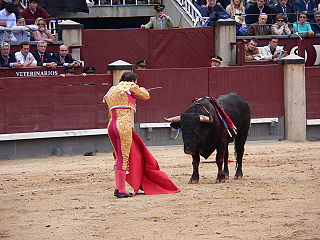Related Research Articles

Miguel Bosé is a Spanish pop singer and actor.

Luis Miguel González Lucas, better known as Luis Miguel Dominguín, was a bullfighter from Spain and son of noteworthy bullfighter, Domingo Dominguín. Dominguín adopted his father's name to gain popularity.

Juan Belmonte García was a Spanish bullfighter. He fought in a record number of bull fights and was responsible for changing the art of bullfighting. He had minor deformities in his legs which forced him to design new techniques and styles of bullfighting.

Manuel Laureano Rodríguez Sánchez, known as Manolete, was a Spanish bullfighter.

Lucia Bosè was an Italian actress.

Francisco de Asís Rivera Ordóñez is a Spanish torero or 'bullfighter'.

The Plaza de Torosde Acho is the premier bullring in Lima, Peru. Located beside the historical center of the Rímac District, the plaza is classified as a national historic monument. It is the oldest bullring in the Americas and the second-oldest in the world after La Maestranza in Spain. It opened on 30 January 1766.
Bernardo del Carmen Fregoso Cázares, who worked and lived under the name Carmelo Torres Fregoso was a matador, businessman, journalist, author and TV producer. He lived in Venezuela from 1952. His first bullfight as "matador" was in Barranquilla, Colombia in 1949 and last in Nezahualcóyotl City, Mexico in 1986. With 37 years of uninterrupted activity this was one of the world's longest careers as a matador.

Spanish-style bullfighting is a type of bullfighting that is practiced in Spain, Mexico, Colombia, Ecuador, Venezuela, Peru, as well as in parts of southern France and Portugal. This style of bullfighting involves a physical contest with humans attempting to publicly subdue, immobilize, or kill a bull. The most common bull used is the Spanish Fighting Bull, a type of cattle native to the Iberian Peninsula. This style of bullfighting is seen to be both a sport and performance art. The red colour of the cape is a matter of tradition – bulls are color blind. They attack moving objects; the brightly-colored cape is used to mask blood stains.

Antonio Cayetano Rivera Ordóñez is a Spanish torero or 'bullfighter'.

The Brave Bulls is a 1949 Western novel written by Tom Lea about the raising of bulls, on the ranch Las Astas, for bullfighting in Mexico.
Minotauromachy is a 19.5 by 27.4” etching and engraving created by Spanish artist Pablo Picasso in Paris in 1935. The etching and resulting prints, literally entitled Minotaur Battle, feature many compositional aspects and themes seen often in Picasso’s art throughout the 1930s. These include the Minotaur, an unconscious or dying female matador on an injured horse, a young girl holding a candle and flowers, a man scaling a ladder, and two women watching with doves from a window. Created during a time of personal turmoil within which Picasso created little artwork, Minotauromachy stands out as a seminal and striking piece with no shortage of artistic interpretations.

Bullfighting is a physical contest that involves a bullfighter attempting to subdue, immobilize, or kill a bull, usually according to a set of rules, guidelines, or cultural expectations.
Paco Cano Lorenza, also known as Canito, was a Spanish photojournalist from Valencia, who specialized in torero photography.
Picasso's written works, that is, works created by Pablo Picasso, are often overlooked in discussion of his long and varied career in the mediums of painting, sculpture, drawing, collage, papier-mâché, (photography), assemblage, ready-mades, printing, ceramics and theatre designs. Despite being immersed in the literary sphere for many years, Picasso did not produce any writing himself until the age of 53. In 1935 he ceased painting, drawing and sculpting, and committed himself to the art of poetry; which in turn was briefly abandoned to focus upon singing. Although he soon resumed work in his previous fields, Picasso continued in his literary endeavours and wrote hundreds of poems, concluding with The Burial of the Count of Orgaz in 1959.
The Picasso Summer is a 1969 drama directed by Serge Bourguignon and Robert Sallin, starring Albert Finney and Yvette Mimieux. The screenplay was written by Ray Bradbury based upon his 1957 short story, "In a Season of Calm Weather."
Luis Gallego Sánchez, known professionally as Luisito Rey, was a Spanish singer-songwriter and music executive, best known as the father and first manager of Mexican singer Luis Miguel.

Timothy Logan Bakewell Davis was an American writer who worked in Hollywood from the mid-1970s until his death March 1, 2016, in Los Angeles, California. He was perhaps best known for having been the son of wealthy American expatriates in Spain who lavishly entertained celebrities and the literati, including Ernest Hemingway in a famous 1959 visit.
Pablo Lozano Martín, commonly known as La Muleta de Castilla, was a Spanish bullfighter and fighting bull cattle rancher, owner of cattle raising Alcurrucén and "Hermanos Lozano".
References
- ↑ Picasso, Pablo (1961). Toros Y Toreros. The Circle of Art. p. 7. OCLC 47723505.
- ↑ Goeppert, Sebastian; Goeppert-Frank, Herma; Cramer, Patrick (1983). Pablo Picasso: Illustrated Books. Patrick Cramer. p. 278.
- ↑ Goeppert, Sebastian; Goeppert-Frank, Herma; Cramer, Patrick (1983). Pablo Picasso: Illustrated Books. Patrick Cramer. p. 279.